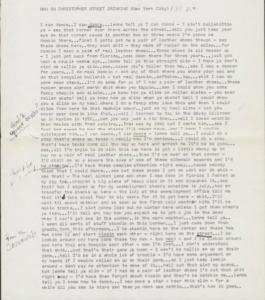In an account in David Wojnarowicz’s journals, the man is seen to be yelling repeatedly of his dancing skills, need for opportunity, and struggle for physical survival. His story parallels that of Patti’s and reflects largely on many New York artists during the 1970s, stressing their deviant attitudes, their appreciation for the city, their financial woes, and their persistent devotion to their craft.
The setting of the account occurs on a street in New York at 1:10 pm. The openness with his inebriated state, especially during a time normally considered to be indecent for drinking, suggests that he does not care for others’ judgments and that he longs to express himself independently of their convictions. Secondly, the man addresses strangers by calling them “slick” and talking to them freely without inhibition, emphasizing his lack of concern for social norms. This sentiment seems to be one shared by many artists during this time, as Patti and Robert take part in activity that is considered to be “deviant” without concern. This “deviance” is even seen in seventies music. Up and coming bands were known for incorporating discussions of prostitution and drugs in their music.
The drunken man claims that he used to be a star back in the fifties while dancing for the Savoy Ballroom in Harlem but then went to Florida, where he has been drinking for three years. He then states that he finally has decided to come back to New York to again pursue his passion for dance, implying that people come to New York to realize their artistic potential and that the city is the first place people think of when looking for opportunity. This is strikingly similar to Patti Smith, who sees New York as a haven for creativity and even leaves her baby and her family to pursue poetry in an entirely foreign place.
The drunken man also notes his financial limitations. He claims that his inability to purchase leather shoes has prevented him from putting on shows and says that if he were to secure funds, he’d “chalk [himself] up a square size of the sidewalk” and “have people’s attention right away.” The man recalls his inability to secure unemployment checks in Florida and says that by the time they arrive he won’t be able to secure a job in New York, adding to his financial troubles but claims that as soon as he receives the money, he will spend it on leather shoes. Tough finances seems to resonate with many of the up and coming artists during the 1970s, as there was an entire hotel dedicated to housing poor artists with the only compensation being their artwork. This account shares many sentiments with Patti’s memoir, as even she would rather purchase artistic materials over food. It also emphasizes that in spite of these struggles, artists invested everything they had and gave their full-fledged effort to succeed. This unchallenged commitment to art was a staple characteristic of artists in this time period of New York.
The drunken man repeatedly yells, “I can dance,” suggesting that he could blow away his audience but continuously says that he cannot perform without his leather shoes. He even says with hyperbole that his dancing would “shake up Texas” and that people would come all the way from there to arrest him. He supports his claims by mentioning specific moves such as his “fancy steppin and slidin” and his “softshoe tap” and citing his past success. He also refers to Fred Astaire, a renown American dancer, as one of his childhood friends and claims that he “coulda outstepped him” and pompously claims that he is so good at dancing that “texas [would have] come all the way up here and arrest [him].” The man’s undoubted belief in his artistic ability parallels that of Patti’s and Robert’s, as they firmly believe in their artistic abilities and continue to pursue them regardless of the variety of obstacles thrown at them. His use of hyperbole and confident statements despite lack of proof implies his passion for his craft and his profound belief in himself. These qualities seem to be a cornerstone of up and coming artists in New York during the seventies.
The drunken man’s account resonates with Patti Smith’s portrayal of New York in the seventies as a place where people tried to capitalize on their artistic talents even in times of poverty and dead end opportunities. The coming of age of an artist often involved financial poverty and social rejection, which were eventually overcome by devotion to the craft.
